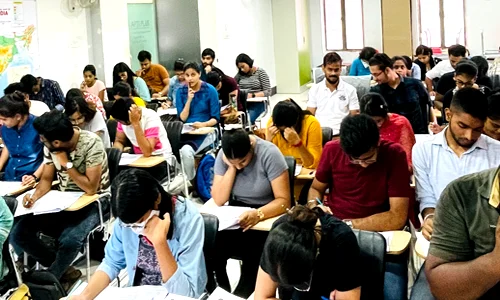



Air pollution is now one of the world’s deadliest environmental threats, contributing to nearly nine million premature deaths each year—largely from heart disease, stroke, lung infections, cancer and chronic respiratory conditions. Most of these deaths occur in low- and middle-income countries where exposure to fine particulate matter, toxic gases and waste emissions is persistently high. The latest assessments show that ninety-nine percent of the global population breathes air that exceeds health guidelines, with climate change, wildfires, unmanaged waste and urban congestion intensifying the crisis. This enormous health burden underscores the urgent need for stronger pollution control, cleaner energy transitions and more effective global cooperation.
Click to View MoreExtreme heat stress during the fourth global bleaching event weakened Goniopora corals at One Tree Reef, triggering an unprecedented outbreak of Black Band Disease. This combination killed 75% of colonies and signals the rapid decline of coral resilience worldwide, with serious ecological and human consequences.
Click to View MorePollution is emerging as a hidden reproductive health crisis, as toxins in air, water, soil and plastics disrupt hormones, damage sperm and egg quality, and increase miscarriage and poor birth outcomes. Evidence from India and globally shows declining fertility, particularly in polluted cities, indicating that cleaner environments are essential for protecting family health and demographic stability.
Click to View MoreWorld Soil Day, observed on 5 December, highlights soil’s vital role in sustaining food systems, climate stability, water regulation and biodiversity. With nearly one-third of global soils degraded and India facing significant land decline, the day underscores the need for scientific soil management, grassland restoration, and farmer-led stewardship. It serves as a reminder that soil is a living resource requiring urgent protection to secure livelihoods, ecological health and long-term sustainability.
Click to View MoreFirst Indian study measuring inhalable microplastics at breathing height across four metros shows plastics now form up to 5% of urban particulate pollution. Markets in Kolkata and Delhi show highest loads. iMPs carry pathogens, heavy metals and toxic chemicals, posing emerging health risks including inflammation, hormonal disruption and possible cancer pathways. Urgent inclusion of microplastics in air-quality regulation is needed.
Click to View MoreWhat is Ganga-Yamuna Water Diversion Plan?
The project aims to improve the Yamuna River's environmental flow, reduce pollution in the Delhi section, and address the city's water shortage.
However, the proposal faces criticism for being a temporary fix that neglects core pollution sources and creates major ecological and inter-state issues.
Click to View MoreA meat tax is being proposed globally as a climate policy tool to reduce the environmental impact of livestock, a sector responsible for 12–19% of global greenhouse gas emissions, especially methane. The tax aims to curb overconsumption—particularly in high-income countries—internalise ecological costs like deforestation and land degradation, and generate revenue for climate action such as the Loss and Damage Fund. However, its implementation faces challenges including political resistance, livelihood concerns for farmers, cultural sensitivities, equity issues for low-income consumers, and difficulties in measuring emissions accurately. While the tax offers a pathway toward sustainable and climate-resilient food systems, it requires careful design to ensure fairness and effectiveness.
Click to View MoreBioremediation uses microorganisms, plants, or engineered biological agents to break down or neutralise pollutants in soil, water, and air. India urgently needs this technology due to widespread contamination of rivers, landfills, industrial clusters, and agricultural soils, coupled with the high cost and limitations of conventional cleanup methods. Government programmes such as DBT–BIRAC funding, NRCP, and Namami Gange have begun supporting pilot-scale bioremediation, while CSIR–NEERI leads scientific development. However, challenges remain—limited site-specific data, weak regulation, low public awareness, and unclear standards for GM microbes. With proper oversight and investment, bioremediation offers a sustainable pathway to restore India’s ecosystems and align with national clean-up missions.
Click to View MoreParticulate Matter, especially the ultrafine PM1 fraction, has emerged as a major public-health concern in India due to its ability to penetrate deep into the lungs, enter the bloodstream and carry highly toxic metals and reactive chemicals. Studies show PM1 is more harmful than PM2.5, yet it remains unmonitored in India’s regulatory framework, creating a significant data and policy blind spot. Research from Delhi reveals PM1 is often underestimated by nearly 20%, masking true exposure levels during severe pollution episodes. The implications are extensive—rising cardiovascular and child-health risks, high indoor infiltration, delayed policy action, and strong climate linkages through black carbon. While India has launched multiple initiatives such as NCAP, GRAP, BS-VI norms, PMUY and stubble-management schemes to curb PM pollution, the absence of PM1 standards limits their effectiveness. Integrating PM1 into national monitoring, regulation and health studies is now essential for comprehensive air-quality governance.
Click to View MoreUN ESCAP’s 2025 report warns that Asian megacities may experience an additional 2–7°C due to urban heat island effects, with India, Pakistan and Bangladesh facing 300+ days above 35°C. Extreme heat is now the region’s fastest-growing climate hazard, threatening health, livelihoods and economic stability.
Click to View MoreIndia’s rapidly growing gig economy has become vital to urban services, but extreme heatwaves are exposing serious gaps in worker protection. Delivery partners, cab drivers, and other platform-based workers are forced to work long hours outdoors without shade, hydration, or social security benefits—putting their health and livelihoods at risk. While advisory measures exist, enforcement remains weak and retaliation against workers raising concerns is common. To sustain both productivity and human dignity in a warming climate, India must strengthen legal safeguards, ensure heat-safety infrastructure, and expand social protection for gig workers.
Click to View More
© 2025 iasgyan. All right reserved